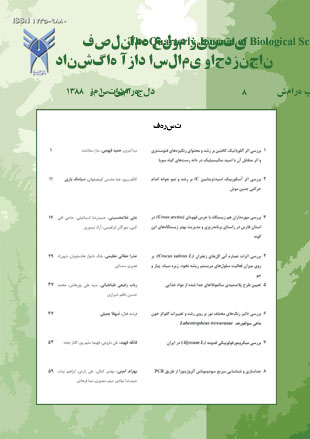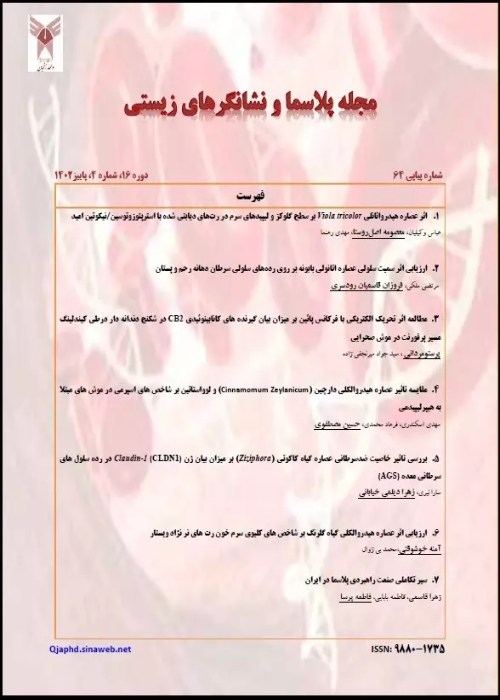فهرست مطالب

نشریه پلاسما و نشانگرهای زیستی
سال سوم شماره 1 (پیاپی 14، زمستان 1388)
- تاریخ انتشار: 1388/10/11
- تعداد عناوین: 8
-
Page 1Caffeine as an important allelochemical agent has physiological or poisonous effecton plants and microbes, and also participates in metabolic and physicochemical processes.Salysilic acid (SA) as a hormone has important roles in developmental regulation,and strongly participates in several biotic and abiotic defense mechanisms. Theaim of this investigation was to study the allelopathic effects of Caffeine on growthand the photosynthetic pigment content in Soybean Seedlings (Glycine max L.), andit’s interaction with Salicylic acid. This experiment was performed using a Two-factorRandomized Complete Block Design. The first factor was 3 levels of Caffeine (0,100, and 200 mg/L), and the second factor was 4 levels of Salicylic acid (0, 50, 75, and100 mg/L), each with 4 replicates on Williams’ Soybean seed variety in the laboratory.Samples were collected on the 14th day post-pretreatment in order to evaluate growthindices and the pigment content. Our results showed that Caffeine and SA, each had asignificant effect on the growth index and the pigment content. Salicylic acid decreasedthe caffeine intensity stress in all measured characteristics. When used in combination,the intensity of Caffeine-induced stress was lowered by the presence of SA, and the effect on pigment content was significant.
-
Page 11Ascorbic acid (vitamin C) is one of the water soluble vitamins. This vitamin is synthesizedfrom glucose in the liver in some mammals. This process is not seen in primatesand the guinea pigs. Vitamin C is an important antioxidant, and plays an essential rolein the synthesis of certain extracellular matrix proteins. In this experimental study weexamined the effects of vitamin C on the limb-bud development in vitro using NMRImouse strain as an Animal model. On day 11.5, pregnant mice were killed and theembryos’ limb-buds were dissected and grouped as control, exp1 & 2. A sample fromeach group was cultured using the Trowell technique in vitro. The different doses ofascorbic acid used in these experiments were 50μg /ml & 100μg /ml for exp1 & 2, respectively.Culture dishes in control samples contained only Eagles Minimum EssentialMedium (EMEM), supplemented with 15% human embryonic cord serum and antibiotics.Samples from the three groups were incubated in 37ºC, 5% CO2 and 95% aircondition. Morphological and histological studies in control, exp1& 2 groups showed adose- related increase in length growth along the proximo-distal axis in exp1 & 2 withrespect to the control group. Number of mesenchymal cells in the experimental groupsdecreased significantly in vitro; this occurs due to the differentiation of mesenchymalcells to chondrocytes. Results also showed a significant increase in the number of redblood cells in the experimental groups. Number of chondrocytes also increased significantlyin the experimental groups. Especially in the proximal zone, hypertrophicchondrocytes were observed in the experimental groups. The results of this study demonstrated that the antioxidative, proliferative and differentiating effects of vitamin C act in a dose dependent manner
-
Page 17Wild life is an important biological parameter in every ecosystem and an importantcriterion in the field of biological diversity. Protecting wild life necessitates the identificationof the different species as well as their interactions with each other and withtheir habitats. The lack of knowledge on the contribution of animals to the biologicaldiversity and their interaction with the environment has resulted in the extinction ofcertain animal species and the disappearance of their habitats. Even in a lot of protectedareas many species are on the verge of extinction. Brown Bear (Ursos arctos) has longbeen an inhabitant of the northern, western and southwestern areas of the country, butthe ongoing destruction of their habitat as well as the human interference has resultedin a decrease in their population and distribution. This study was aimed at assessing theconditions of the Brown Bear habitat and identifying their coexisting species with thehope of providing a better strategy for a proper management of their habitats. Alongwith the recognition of the properties of the Brown Bear habitats, some of its coexistingspecies were also sampled and identified. The data collected through this study demonstrate a very high diversity in vertebrate species (161 species) that include; 27 mammals, 82 birds, 22 reptiles, 3 amphibians and 27 fishes. Of all the identified species,2 species of fishes, 3 species of amphibians, 1 species of reptiles, 70 species of birdsand 15 species of mammals are on the IUCN red list. Of these, one species is listed asendangered and five as vulnerable in this list, while three species have been consideredas endangered by the internal regulations. Therefore, considering the conservation andmanagement of these co-existing species in the Brown Bear management program inthis province appears inevitable.
-
Page 29Saffron (Crocus sativus L.) has long been used as a herbal medicine, and serves asa rich source of carotenoids with anti-cancer and anti-tumor effects. The biologicalactivity of Saffron flower organs is correlated with the chemical composition and concentrations of the main biologically active ingredients in each organ. The present comparative study was designed to evaluate the antimitotic activity of petals, stamens andstigma water extracts of saffron flowers in root meristematic cells of Chickenpea (Cicerarietinum L.), Caraway (Carum carvi), Onion (Allium cepa L.) and Barley (Hordeumvulgare L.). The antimitotic effects of these extracts were determined using root growthand cell division assays. All flower extracts had antimitotic effects on root meristematiccells. Extracts of stigma and petals possessed the most and the least inhibitory effectson spindle formation, respectively. It is speculated that the difference in the antimitoticactivitity of these extracts correlates with the difference in chemical compositionand concentrations of biologically active carotenoid ingredients present in each Saffronflower organ.
-
Page 37Among the gram negative bacteria causing food born enteritis, the most importantorganisms belong to the members of Salmonella genus. In this investigation, threemethods of Serotyping, Resistotyping and Plasmid Profile Analysis were used to studythe Salmonella strains isolated from food products. A total of 50 Salmonella strainsisolated from food products and sent to the Veterinary Organization of Tehran Provinceand pasteur Veterinary Laboratory were studied from April to August 2005. Serotypingwas performed using the Mast Diagnostic Kit. Resistotyping was performed by Kirbyand Bauer disk diffusion method according to the NCCLS criteria. Plasmids were extractedusing Takara kit (Takara company, Japan) and electrophoresed on a 1% Agarosegel. Fifty Salmonella strains belonged to 11 serotypes. S. Durban was the most commonserotype followed by S. Nigeria and S. Thompson. All 50 Salmonella strains were resistantto Ampicillin and Streptomycin. Resistance to three or more antibiotics (MDR)was detected for 58% of the studied strains. Strains showed 6 different resistance patterns.The most common resistance pattern was S. Am. Gm. Cz. Te. All fifty Salmonellastrains contained one to four plasmids and showed 4 different plasmid profiles. All thestrains had a 3.036 MD plasmid and all these serotypes were resistant to Ampicillinand Streptomycin. Serotyping distinguished more strains than did the two other methods.Since our strains contained very few plasmids, this method could distinguish fewstrains. However, the method of Plasmid Profile Analysis showed that all the strainscontained a 3.036 MD plasmid that can be considered as a common characteristic ofSalmonella strains isolated from food products.
-
Page 47Light is an effective factor in the metabolism, growth and locomotion of fishes. Due tothe importance of vision in the nutrition of fishes in pisciculture, this research was designed to study the effect of different colors of light on certain growth and survival parameters, and glucose levels in Cichild sulfur head (Labeotropheus trewavasae). A totalof 150 fishes, each weighting an average of 2 grams were selected, and were randomlytransferred to 4 different aquariums (about 12 fishes per tank) in three replicates. Afterbeing adapted to their environment, their tanks were illuminated with a different colorof light (sunlight, red, blue and white light). The 40-50 watt bulbs (blue, red or white)were situated over the tanks at a distance of 40 cm. The photoperiod duration was maintained at a 12-hour photoperiod. Larval feeding lasted for 75 days, and the biometry of the fishes was performed once every 14 days. Data were calculated and analyzed usingthe ANOVA (Analysis Of Variance). Results indicated that the fishes exposed to whiteand red lights weighed the most and the least, respectively. The difference between thetreated and the control lines were insignificant. The longest and the shortest fishes werethe ones treated with white and red light, respectively. The highest and the lowest levelsof glucose were observed in red and white light-treated fishes, respectively. The highestand the lowest FCR (Feed Conversion Ratio) was recorded in fishes grown under redand white light, respectively, which was significantly (P<0.05) different between thetreatments. The highest SGR (Specific Growth Rate) or CF (Condition Factor) and HSI(Hepato-Somatic Index) were recorded for white light-treated fishes, and the lowestwas recorded for the red light-treated ones. The highest and the lowest survival rateswere observed in white and red light-treated fishes, respectively, and a significant (P=0.05) difference was determined between the treatments. The higher wavelength of redlight is absorbed at the top layers of water, whereas the white light which is a combination of all the wavelengths present in a light spectrum, including yellow, orangeand green is highly absorbed by the Sulfur head fishes. White light resembles the lightspectrum of the natural environment of fishes and thus can be an appropriate light forthe growth of these fishes.
-
Page 53Seed coat morphology is an excellent characters for taxonomic and evolutionary studies.Thus, understanding its structure and development has set an important goal forbiologists. Alyssum genus belongs to the Brassicaceae family with 36 annual and perennialspecies. These species are polymorphic in morphological characters, making theiridentification difficult. In this study, seed micromorphological characters of eight Alyssumspecies were examined through Scanning Electron Microscopy (SEM). Sculpture,size and the thickness of cell walls as well as the shape of cells in the seed were assayed.Presence or absence of the wing around the seed and the ornamentation are importantfactors in distinguishing the Alyssum species. Based on our results, subspecies of thethree species A. desertorum, A. linifolium and A. minus were distinguished from eachother using the micro-morphological characters.


